Omron Digital Automatic BP Monitor HEM-7113 User Manual
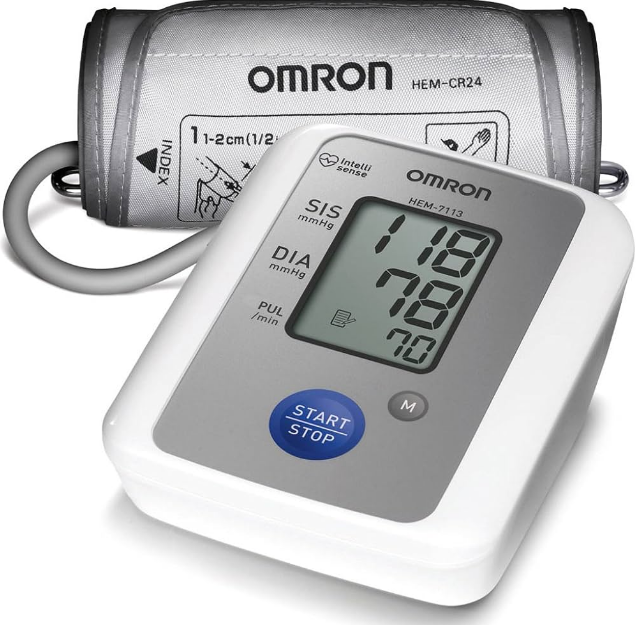
Content
Introduction
The Omron Digital Automatic BP Monitor HEM-7113 is a user-friendly device designed for convenient home blood pressure monitoring. Launched in 2015, this monitor is manufactured by Omron Corporation, a leading name in healthcare technology. Priced at approximately $49.99, the HEM-7113 features an automatic measurement function, providing accurate readings from the wrist, making it ideal for individuals seeking to manage their blood pressure effectively in a home setting.
The OMRON HEM-7113 is a fully automatic blood pressure monitor, operating on the oscillometric principle. It measures your blood pressure and pulse rate simply and quickly. The unit also stores up to 14 measurements in memory.
Intended Use
This product is designed to measure the blood pressure and pulse rate of people within the range of the designated arm cuff, following the instructions in this instruction manual. It is mainly designed for general household use. Please read the Important Safety Information in this instruction manual before using the unit.
Overview
Main unit
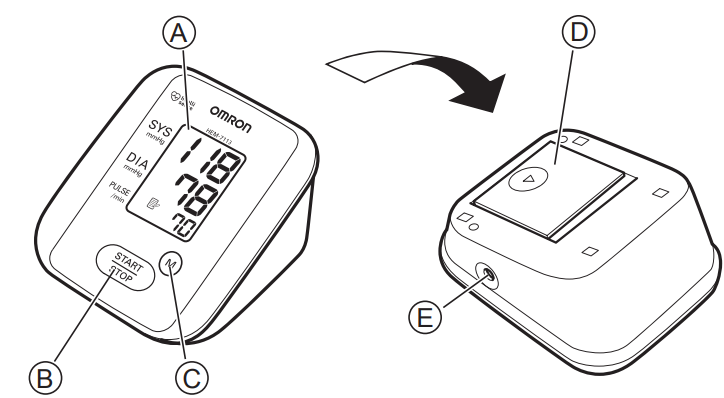
- Display
- START/STOP button.
- Memory button
- Battery compartment
- Air jack
Arm cuff

If air starts to leak from the arm cuff, please replace with a new one. Refer to “6. Optional Parts”.
- F. Arm cuff
(Medium cuff: arm circumference 22-32 cm) - G. Air tube
- H. Air plug
Note: The optional arm cuff does not include the air plug. Do not throw the air plug away in case purchasing the new one.
Package contents
I. Four “AAA” alkaline (LR03) batteries
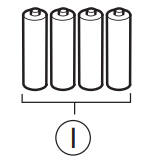
- Instruction manual
- Blood pressure monitor unit
Display
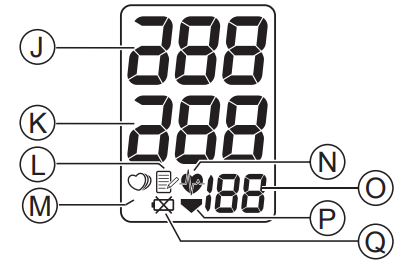
- J. Systolic blood pressure
- K. Diastolic blood pressure
- L. Memory symbol
- M. Irregular Heartbeat symbol
- N. Heartbeat symbol
- Flashes during measurement
- If flashing after measurement complete indicates blood pressure out of recommended range
- O. Pulse display
- P. Deflation symbol
- Q. Battery low symbol
Note: If your systolic or diastolic pressure is outside the standard range (above 135/85 mmHg), the Heartbeat symbol ( ) will blink. Refer to “3.2 Taking a Reading”.
Technical Data
| Specification | Details |
|---|---|
| Product | Automatic Blood Pressure Monitor |
| Model | HEM-7113 (HEM-7113-AP) |
| Display | LCD Digital Display |
| Measurement Method | Oscillometric method |
| Measurement Range | Pressure: 0 mmHg to 299 mmHg; Pulse: 40 to 180/min. |
| Memory | 14 Measurements |
| Accuracy | Pressure: ±3 mmHg; Pulse: ±5% of display reading |
| Inflation | Automatic by electric pump |
| Deflation | Automatic pressure release valve |
| Power Source | 4 "AAA" batteries 1.5V |
| Battery Life | Capacity of new alkaline batteries is approximately 300 measurements |
| Applied Part |  Type B Type B |
| Protection Against Electric Shock | Internally powered ME equipment |
| Operating Temperature/Humidity | 10°C to 40°C / 30 to 85% RH |
| Storage Temperature/Humidity/Air Pressure | -20°C to 60°C / 10% RH - 95% RH / 700-1060 hPa |
| Console Weight | Approximately 245 g without batteries |
| Cuff Weight | Approximately 120 g |
| Outer Dimensions | Approximately 104 (w) mm × 64 (h) mm × 128.5 (l) mm |
| Cuff Dimensions | Approximately 146 mm × 446 mm (Medium cuff: arm circumference 22 to 32 cm) |
| Package Content | Main unit, cuff, Instruction manual, Battery set |
Notes:
- Subject to technical modification without prior notice.
- Disposal of this product and used batteries should be carried out in accordance with the national regulations for the disposal of electronic products.
Optional Parts
Medium arm cuff Arm circumference
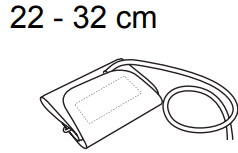
Large arm cuff Arm circumference
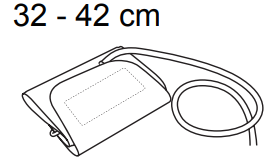
Description
The Omron HEM-7113 features a sleek and ergonomic design that makes it comfortable to use. The large LCD display ensures that readings are clear and easy to read, even for those with vision impairments. The device comes with a latex-free cuff that is adjustable to fit various arm sizes, ensuring a comfortable and accurate fit.
The monitor includes a hypertension indicator that alerts users if their blood pressure readings fall into the hypertensive range. This feature is particularly useful for individuals who are monitoring their blood pressure as part of a health management plan.
Preparation
Installing/Replacing the Batteries
- Turn the main unit upside down.
Slide the battery cover in the direction of the arrow while pressing the ribbed part of the cover.
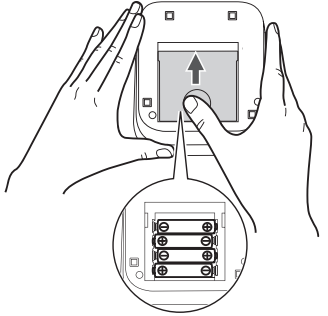
- Install or replace four “AAA” size batteries so that the + (positive) and - (negative) polarities match the polarities indicated on the battery compartment.
Put the battery cover back in place.
Slide the battery cover as indicated, until it clicks into place.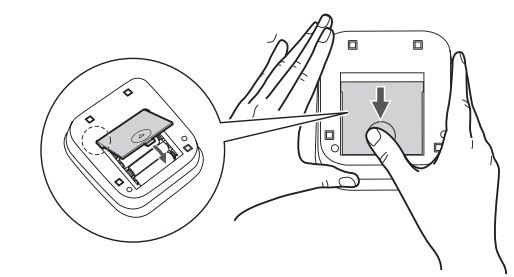
Note: The measurement values continue to be stored in memory even after the batteries are replaced.
Battery Life & Replacement
If the battery low symbol (![]() ) appears on the display, replace all four batteries at the same time.
) appears on the display, replace all four batteries at the same time.

- When the battery low symbol (
 ) starts to blink, you will still be able to use the unit for a short while. You should replace the batteries with new ones ahead of time.
) starts to blink, you will still be able to use the unit for a short while. You should replace the batteries with new ones ahead of time. - When the symbol (
 ) remains lit, the batteries are exhausted. You should replace the batteries with new ones at once. Turn the unit off before replacing the batteries.
) remains lit, the batteries are exhausted. You should replace the batteries with new ones at once. Turn the unit off before replacing the batteries.
- Remove the batteries if the unit will not be used for three months or more.
- Dispose of batteries according to applicable local regulations.
Four new “AAA” alkaline batteries will last for approximately 300 measurements, when used to take two measurements a day. Since the supplied batteries are for monitoring use only, they may have a shorter life and not last for 300 measurements.
Using the Unit
Applying the Arm Cuff
Be sure to wrap the arm cuff correctly so that you get accurate results. Measurements can be taken in light clothing. However, please remove thick clothes, such as sweaters, before taking a reading.
Note:
You can take a measurement on either your left or right arm. The blood pressure can differ between the right arm and the left arm and therefore also the measured blood pressure values can be different. OMRON recommends to always use the same arm for measurement. If the values between the two arms differ substantially, please check with your physician which arm to use for your measurement.
- Insert the air plug into the air jack on the left side of the main unit.
Apply the arm cuff to your upper arm. The air tube should be centred on the inside of your arm and point down the inside of the arm, so that the air tube runs down the inside of your forearm and is in line with your middle finger.

When the cuff is positioned correctly, close the fabric fastener firmly.
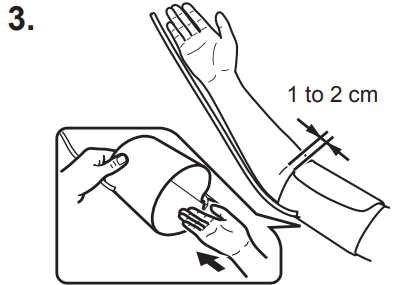
Taking a Reading on the Right Arm
Apply the cuff so that the air tube is at the side of your elbow.
Notes:
- Be careful not to rest your arm on the air tube, or otherwise restrict the flow of air to the cuff.
- The cuff should be 1 to 2 cm above the elbow.
Taking a Reading
- Sit on a chair with your feet flat on the floor and place your arm on a table so that the arm cuff will be at the same level as your heart.
Keep still and do not talk during measurement. - Press the START/STOP button to turn on the unit.
Note: To cancel a measurement, press the START/STOP button to turn off the unit and to release the air in the arm cuff. Check the measurement results.
The unit automatically stores blood pressure and pulse rate into its memory. Refer to “3.4 Using the Memory Function”.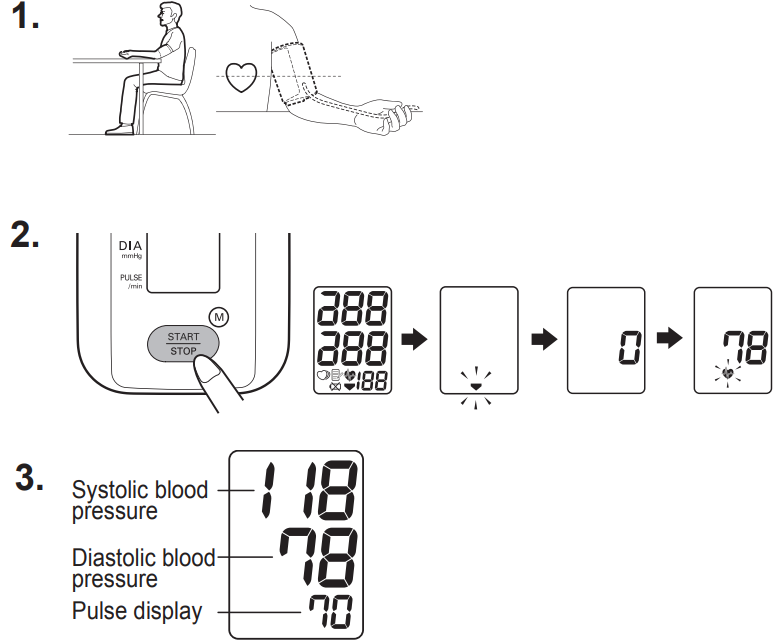
Notes:
- Self-diagnosis of measured results and treatment are dangerous. Please follow the instructions of your doctor.
- Wait 2-3 minutes before taking another blood pressure reading. Waiting between readings allows the arteries to return to the condition prior to taking the blood pressure measurement.
Remove the arm cuff.
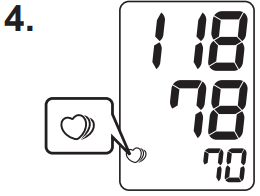
Important: Your blood pressure monitor includes an irregular heartbeat feature. Irregular heart- beats can influence the results of the measurement. The irregular heartbeat algorithm automatically determines if the measurement is usable or needs to be repeated. If the measurement results are affected by irregular heartbeats but the result is valid, the result is shown together with the irregular heartbeat symbol (
 ). If the irregular heartbeats cause the measurement to be invalid, no result is shown. If the Irregular heartbeat symbol (
). If the irregular heartbeats cause the measurement to be invalid, no result is shown. If the Irregular heartbeat symbol ( ) is shown after you have taken a measure-ment, repeat the measurement. If the Irregular heartbeat symbol (
) is shown after you have taken a measure-ment, repeat the measurement. If the Irregular heartbeat symbol ( ) is shown frequently, please make your doctor aware of it.
) is shown frequently, please make your doctor aware of it.
What is Irregular Heartbeat?
An irregular heartbeat is a heartbeat rhythm that varies by more than 25% from the average heartbeat rhythm detected while the unit is measuring the systolic and diastolic blood pressure. If such an irregular rhythm is detected more than twice during measurement, the irregular heartbeat symbol ( ) appears on the symbol when the measurement results are displayed.
) appears on the symbol when the measurement results are displayed.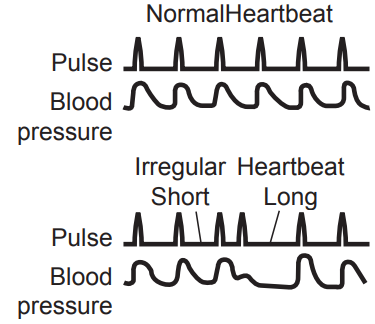
What is Arrhythmia?
A heartbeat is stimulated by electrical signals that cause the heart to contract. Arrhythmia is a condition where the heartbeat rhythm is abnormal due to flaws in the bio-electrical system that drives the heartbeat. Typical symptoms are skipped heartbeats, premature contraction, an abnormally rapid (tachycardia) or slow (bradycardia) pulse. This can be caused by heart disease, aging, physical predisposition, stress, lack of sleep, fatigue etc. Arrhythmia can only be diagnosed by a doctor through a special examination. Whether the appearance of the irregular heartbeat symbol ( ) in the results indicates arrhythmia or not can only be determined by an examination and diagnosis by your doctor.
) in the results indicates arrhythmia or not can only be determined by an examination and diagnosis by your doctor.
Warning: If the irregular heartbeat symbol ( ) is shown frequently, please make your doctor aware of it. Conducting self-diagnosis and treatment based on measurement results is dangerous. Be sure to follow the instructions of your doctor.
) is shown frequently, please make your doctor aware of it. Conducting self-diagnosis and treatment based on measurement results is dangerous. Be sure to follow the instructions of your doctor.- Press the START/STOP button to turn the unit off.
Note: If you forget to turn the unit off, it will automatically shut itself off after five minutes.
Instructions for Special Conditions
If your systolic pressure is known to be more than 220 mmHg, press and hold the START/STOP button until the arm cuff inflates 30 to 40 mmHg higher than your suspected systolic pressure.
Press the START/STOP button to turn the unit on. Measurement starts.
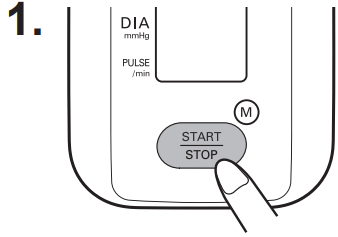
- When the cuff starts to inflate, press the START/STOP button and keep it pressed until the pressure is 30 to 40 mmHg higher than your suspected systolic pressure.
Note: You cannot inflate the cuff above 299 mmHg. (An error will be displayed if you try to inflate the cuff above 299 mmHg.) - Release the START/STOP button when the cuff has been inflated to the desired pressure.
The cuff starts to deflate and measurement starts. - The rest of the procedure is the same as for normal measurement. Refer to “3.2 Taking a Reading”, steps 3 to 5. Note: Do not apply more pressure than necessary.
Using the Memory Function
This unit has a memory capable of storing 14 sets of readings.
Note: If the memory is full, the monitor will delete the oldest readings.
- Press the Memory (M) button.
The result from the most recent measurement is displayed.
Important: If your systolic or diastolic pressure is outside the standard range, the heartbeat symbol will blink when the measurement result is displayed.
Refer to “3.2 Taking a Reading”.
Note: If there are no measurements results stored in memory, the screen to the right is displayed. Press the Memory (M) button repeatedly to cycle through the previous measurement results.
The Memory number appears for a second before the pulse rate is displayed.
The newest set is numbered “1”.
At the end of the measurement, if an irregular heartbeat is detected, the irregular heartbeat symbol will be displayed with the result.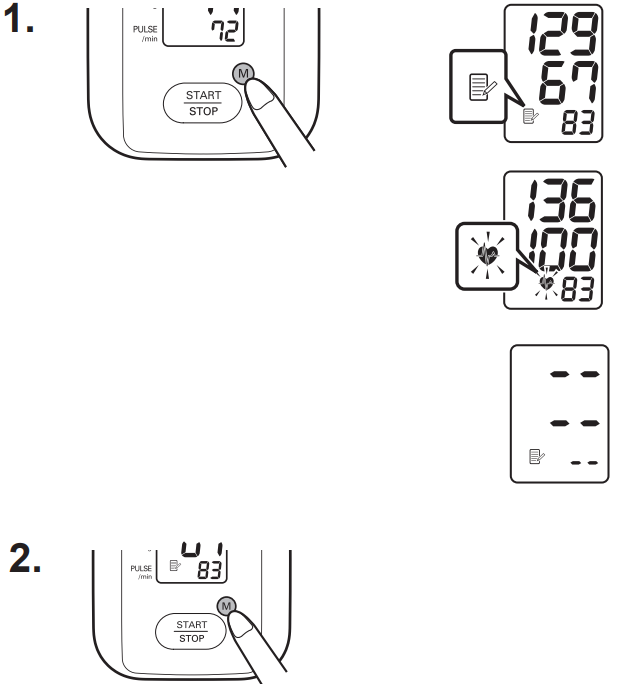
- Press the START/STOP button to turn the unit off.
If you forget to turn the unit off, it will automatically shut itself off after five minutes.
To Delete All the Values Stored in Memory
You cannot delete individual stored readings, all the readings in the unit will be deleted.
To delete stored readings, first press the Memory (M) button.
Then while holding it down, press the START/STOP button simultaneously for about 2-3 seconds. All readings will then be deleted.
- Press the START/STOP button to turn the unit off. If you forget to turn the unit off, it will automatically shut itself off after five minutes.
Setup Guide
To operate the Omron HEM-7113, simply follow these steps:
- Insert the batteries into the device.
- Wrap the cuff around your upper arm, ensuring it is snug but not too tight.
- Press the start button to begin the measurement process.
- The monitor will automatically inflate and deflate the cuff, taking your blood pressure reading.
- Read your blood pressure and pulse rate on the LCD display.
No complex assembly or configuration is required, making it user-friendly for all ages.
Maintenance and Storage
Maintenance
To protect your unit from damage, please observe the following:
- Do not subject the main unit and cuff to extreme temperatures, humidity, moisture or direct sunlight.
- Do not fold the cuff or tubing tightly.
- Do not disassemble the unit.
- Do not subject the unit to strong shocks or vibrations (for example, dropping the unit on the floor).
- Do not use volatile liquids to clean the main unit.
- Do not wash the arm cuff or immerse it in water.
- Do not use petrol, thinners or similar solvents to clean the arm cuff.
- Do not carry out repairs of any kind by yourself.
If a defect occurs, consult your local authorized OMRON distributor or dealer.

- The unit should be cleaned with a soft, dry cloth.
- Use a soft, moistened cloth and soap to clean the arm cuff.
Calibration and Service
The accuracy of this blood pressure monitor has been carefully tested and is designed for a long service life. It is generally recommended to have the unit inspected every two years to ensure correct functioning and accuracy. Please consult your local authorized OMRON distributor or dealer.
Storage
Unplug the air tube from the air jack. Gently fold the air tube into the arm cuff.

Note: Do not bend the air tube excessively.
Do not store the unit in the following situations:
- If the unit is wet.
- Locations exposed to extreme temperatures, humidity, direct sunlight, dust or corrosive vapours.
- Locations exposed to vibrations, shocks or where it will be at an angle.
Handling Errors and Problems
Error Messages
| Error Display | Cause | Remedy |
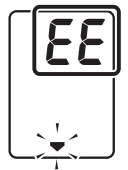 |
Cuff is under inflated. |
Carefully read and repeat the steps listed in section 3.3. |
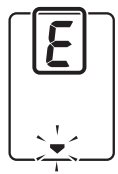 | Movement during measurement. | Repeat measurement. Remain still and do not talk during measurement. |
Air plug disconnected. | Insert the air plug securely. Refer to section 3.1. | |
| Arm cuff not applied correctly. | Apply the arm cuff correctly. Refer to section 3.1. | |
| Clothing is interfering with the arm cuff. | Remove any clothing interfering with the arm cuff. | |
| Air is leaking from the arm cuff. | Replace cuff with new one. | |
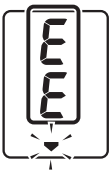 |
Arm cuff has been inflated above 299 mmHg. |
Do not inflate the arm cuff above 299 mmHg. Refer to section 3.3. |
| Error Display | Cause | Remedy |
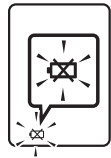
Blinks or appears continuously |
Battery power is low. |
Replace all four “AAA” batteries with new ones. Refer to section 2.1. |
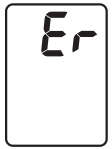 |
Device error. |
Contact your local authorized OMRON distributor or dealer |
Note: The irregular heartbeat symbol (![]() ) may also be displayed with error messages.
) may also be displayed with error messages.
Troubleshooting
| Problem | Cause | Remedy |
The reading is extremely low (or high). |
Arm cuff not applied correctly. | Apply the arm cuff correctly. Refer to section 3.1. |
Movement or talking during measurement. | Remain still and do not talk during measurement. | |
| Clothing is interfering with the arm cuff. | Remove any clothing interfering with the arm cuff. | |
Arm cuff pressure does not rise. |
The air plug is not securely inserted into the main unit. | Make sure that the air jack is connected securely. Refer to section 3.1. |
| Air is leaking from the arm cuff. | Replace the arm cuff with a new one. | |
Arm cuff deflates too soon. |
The arm cuff is loose. |
Apply the cuff correctly so that it is firmly wrapped around the arm. Refer to section 3.1. |
Cannot measure or readings are too low or too high. |
The arm cuff has not been inflated sufficiently. |
Inflate the cuff so that it is 30 to 40 mmHg above your previous measurement result. Refer to section 3.3. |
| The unit loses power during measurement. | The batteries are empty. | Replace the batteries with new ones. |
Nothing happens when you press the buttons. | The batteries are empty. | Replace the batteries with new ones. |
| The batteries have been inserted incorrectly. | Insert the batteries with the correct (+/ -) polarity. | |
Other problems. | Press the START/STOP button and repeat measurement. If the problem continues, try replacing the batteries with new ones. If this still does not solve the problem, contact your local authorized OMRON distributor or dealer. | |
Omron Digital Automatic BP Monitor HEM-7113 Pros & Cons
Pros
- Ease of use with one-touch operation
- Accurate readings with automatic inflation and deflation
- Large LCD display for easy reading
- Affordable price point
- Compact and lightweight design
- Latex-free cuff for comfort and safety
Cons
- Battery life could be longer
- Limited memory storage (up to 14 readings)
- No Bluetooth or wireless connectivity for data transfer
Customer Reviews
Users of the Omron HEM-7113 have generally praised its ease of use and accuracy. Many have found it to be a reliable tool for monitoring their blood pressure at home. However, some users have noted that the battery life could be improved and that the memory storage is somewhat limited.
Common complaints
Include occasional inaccuracies if the cuff is not fitted correctly and the lack of wireless connectivity for syncing data with smartphones or computers.
Faqs
How do I ensure accurate readings with the Omron Digital Automatic BP Monitor HEM-7113?
What is the hypertension indicator on the BP Monitor?
How do I replace the batteries in the Omron?
Can I use the Omron Digital Automatic BP Monitor for multiple users?
How often should I calibrate my Omron?
What is the warranty period for the Digital Automatic?
Can I use the Omron if I have a pacemaker?
How do I clean and maintain my Omron?
What if my BP Monitor HEM-7113 shows an error message?
Is the Omron BP Monitor HEM-7113 compatible with all arm sizes?
Leave a Comment
